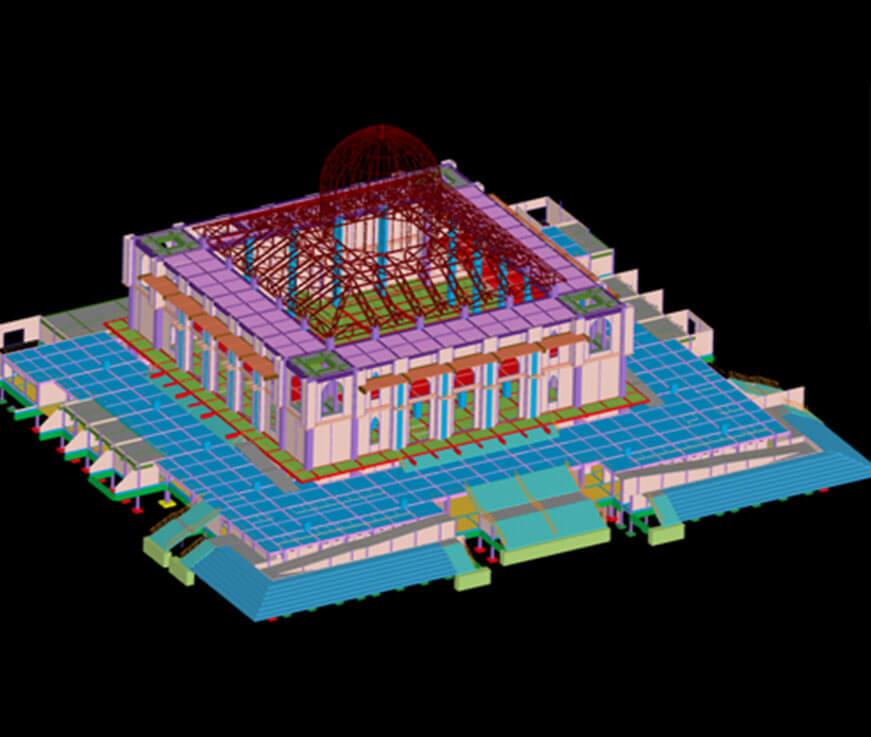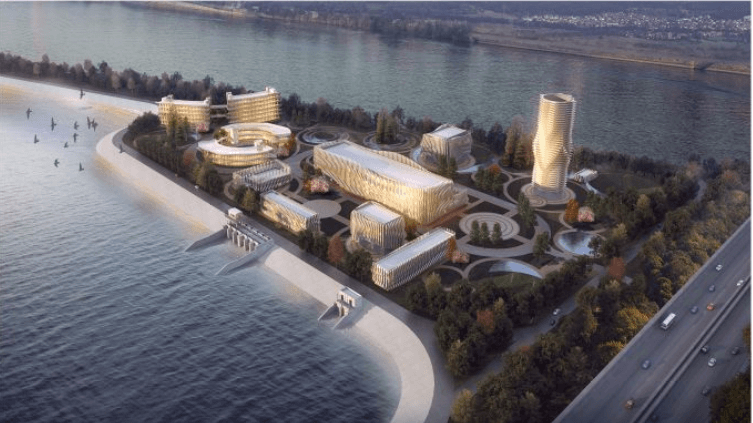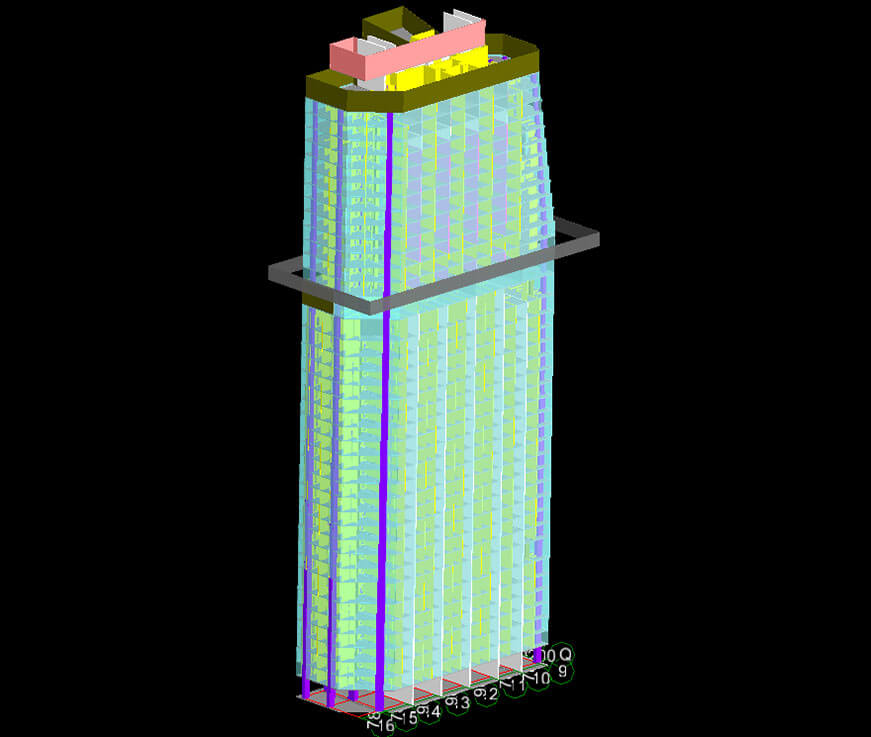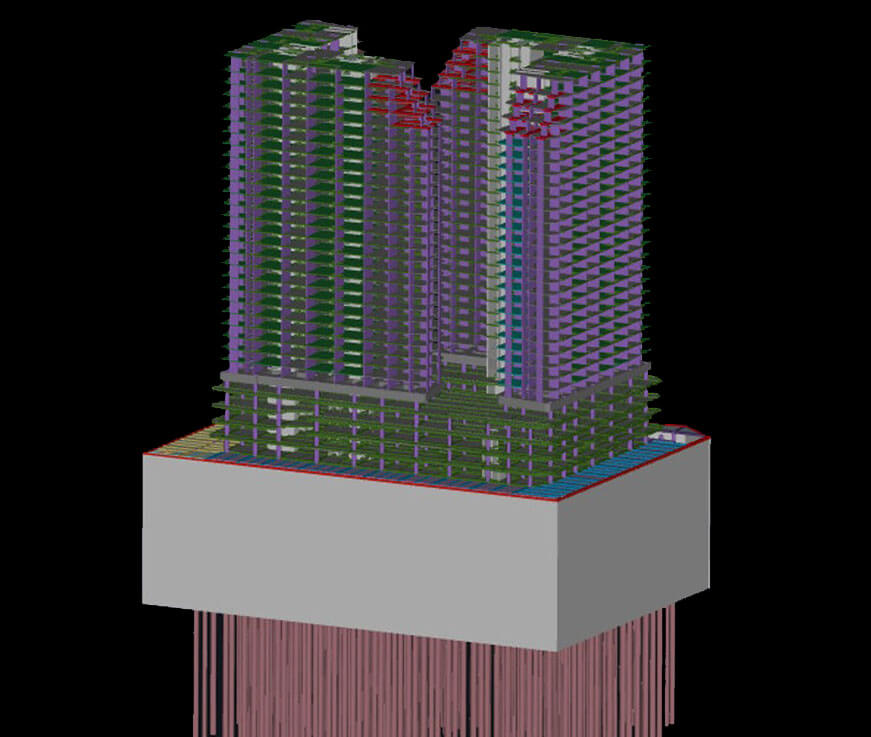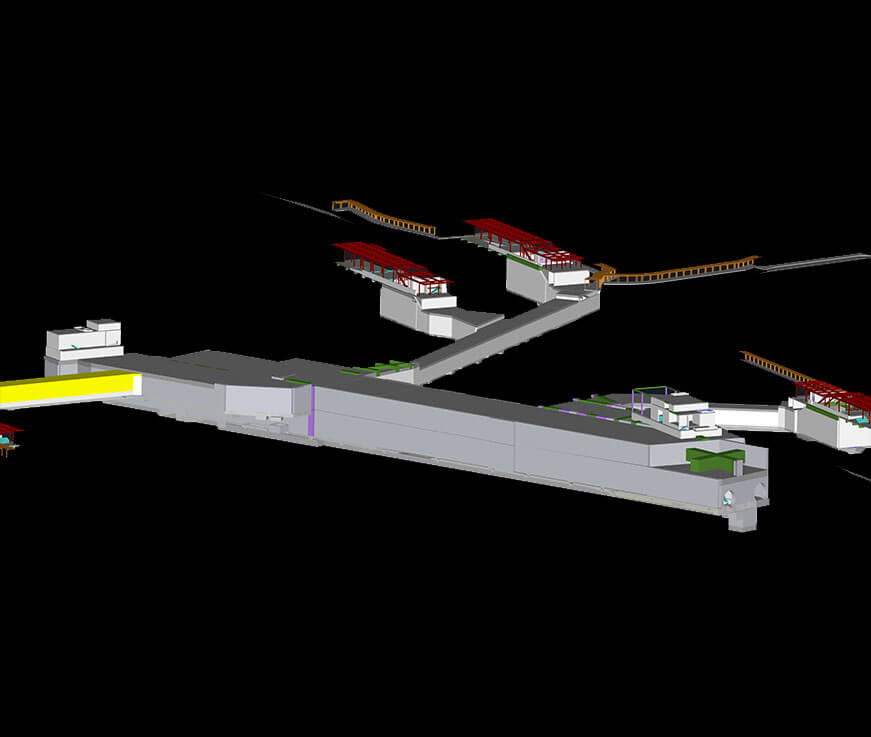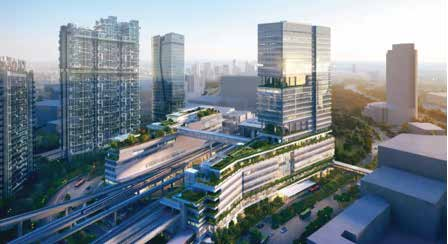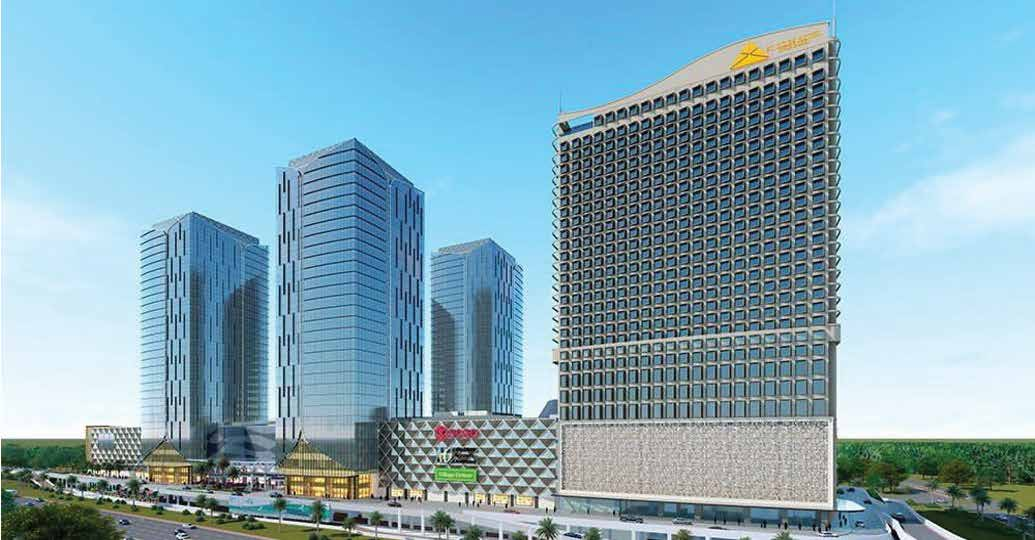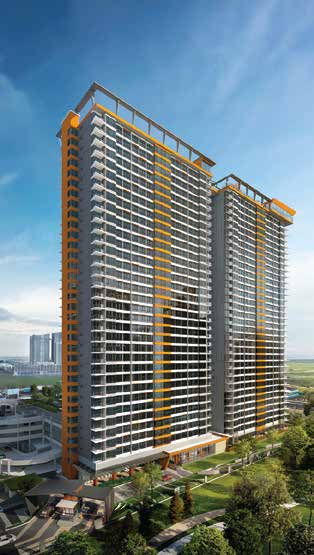Zhengzhou Longfor Financial Island
Zhengzhou, China
-
Project Type & Description: Financial Island, including hotels, apartments, and Class 5A office buildings
-
Gross Floor Area: 880,000 ㎡
-
Main Contractor: China Construction Fifth Engineering Division Corp., Ltd.
-
Designer: Arata Isozaki, Japan
-
Contract Amount: CNY 5 billion (Approximately 0.78billion USD)
-
Glodon Products Involved: BIM5D, Glodon’s civil quantity takeoff software, Gwork, Glodon GCB (construction site layout software), Glodon GMJ (formwork and scaffold design software)
BIM 5D Shapes Construction of a Landmark Financial Island in Henan
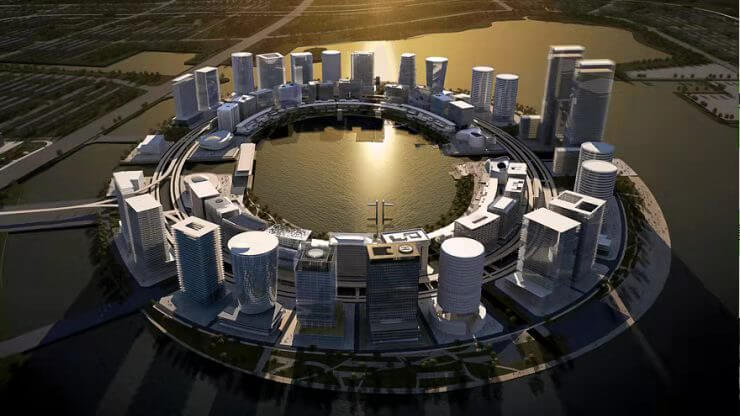 This project was led by the knowledgeable and world influential Japanese architect Arata Isozaki. The whole island is surrounded by water, and it connects large area of green space, flowing water system, and different city functional area, making this district a living city! In this project, the contractor, China Construction Fifth Engineering Division Corp., Ltd, with the aid of the BIM5D technology, found more than 3,900 conflicts, optimized more than 1,500 drawings, and applied 7 patents for utility models and 1 patent for invention.
This project was led by the knowledgeable and world influential Japanese architect Arata Isozaki. The whole island is surrounded by water, and it connects large area of green space, flowing water system, and different city functional area, making this district a living city! In this project, the contractor, China Construction Fifth Engineering Division Corp., Ltd, with the aid of the BIM5D technology, found more than 3,900 conflicts, optimized more than 1,500 drawings, and applied 7 patents for utility models and 1 patent for invention.
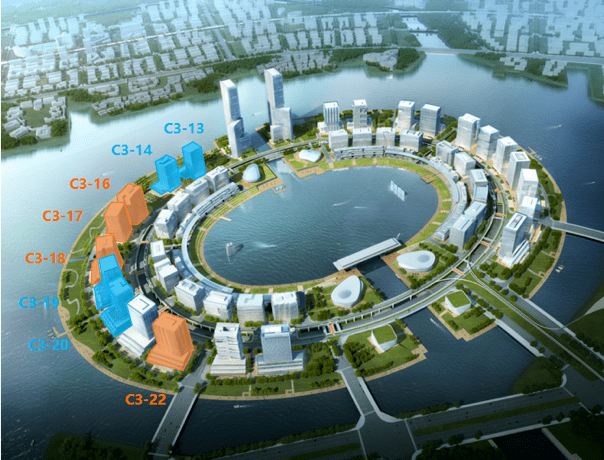 The Project is located in the heart of the national central city of Zhengzhou, i.e., the North Longfor in Zhengdong New District; it is planned and designed under the leadership of the Japanese architect Arata Isozaki, and is called the “Lujiazui of Henan".
The Project is located in the heart of the national central city of Zhengzhou, i.e., the North Longfor in Zhengdong New District; it is planned and designed under the leadership of the Japanese architect Arata Isozaki, and is called the “Lujiazui of Henan".
The Financial Island includes inner and outer rings, with 19 buildings in the inner ring and 24 buildings in the outer ring. China Construction Fifth Engineering Division Corp., Ltd. undertakes 8 plots in the outer ring. The building forms include hotels, apartments, and Class 5A office buildings, and there are 4 floors underground and 22 floors above ground. The building height is 99.8m, with the gross floor area about 880,000m2, and the contract amount is about CNY 5 billion (Approximately 0.78 billion USD).
i. Challenges
-The Project is a landmark building in Henan Province, with high social attention and high-quality standards.
-There are many participants, including 6 constructors, 5 supervisors, more than 30 design institutes, and over 100 subcontractors, resulting in great difficulties in management by the Main Contractor.
-The Project is built near a lake and the groundwater level is high. The underground structures of various plots are connected to form a foundation pit. The area of the deep foundation pit is about 120,000m2 and the depth is 14.5m. The construction of deep foundation pit works and waterproof works is difficult.
-The four floors outside the basement of the Project are connected with the outer ring road, and the inner side is adjacent to the underground utility tunnel and affected by 3 lake crossing tunnels, 2 metro lines, and 4 metro stations.
ii. BIM Application Scheme
3D model: It is created for all disciplines to conduct conflict detection as well as detailed design and optimization of drawings for civil engineering, M&E, and other disciplines.
Deep simulation: It is carried out for key procedures such as waterproof curtain, earthwork excavation, and removal of internal support of complex deep foundation pit works of the Project to analyze unfavorable factors and optimize the method statement.
Data collection: The application of BIM + VR + AR, deep foundation pit calculation and analysis, BIM + progress cloud, and BIM + lightweight platform is researched to achieve real-time uploading and automatic collection of data such as sporadic labor, material acceptance, and progress measurement on site.
iii. Solution
a. BIM Technology Specification
a) Drawing visualization:
Standard models such as civil engineering and M&E models were created according to the standard modeling process of the company to provide basic data for BIM technology expansion. In the process of modeling, model files and members were named and managed uniformly according to the building, discipline, floor, and member number. Naming format of the basic template: The name of the basic template file of the Project is Grid.rvt; naming format of the model file: project name abbreviation - creator - discipline - building number - floor. Suffix; the color selection standard for disciplines was established to avoid any color conflict.
In addition, for the drawings of different design institutes and the drawings of different disciplines of the same design institute, a general coordinate system was defined, and axis network files were unified; boundary angle points of the exterior wall of the basement were selected as the base points to ensure the accuracy of model integration.
b) Joint review and detailed design of drawings
-Joint review and detailed design of civil drawings: In the project modeling process, 15 major problems were found in drawings. For example, in the process of civil modeling of Building 19, 800 X 1000 girders were found in 4# staircases on all standard floors, resulting in an insufficient clear height of the rest platforms; in the process of the integration of the main structure model with the foundation pit support model, it was found that there were cantilever slabs designed for basement 1 structures of all buildings close to the middle ringside, and inclined cantilever beams were designed below the cantilever slabs. The elevation of the cantilever beam and that of the camp shed for the foundation pit support conflicted; it was found during the structural conflict inspection that there were more than 760 structural conflicts to be adjusted in Building 9.
In addition, it was found that there was a narrow and semi-closed section, i.e., the extra trench, under the support replacement sheet strips of basement 4. The cast-in-place pile for supporting was located outside, the exterior wall of the basement was located inside, alternately distributed support replacement sheet strips were on the top, and the extra trench was only 0.5-1m wide. According to the drawing design, plain soil and brick formworks were used for backfilling in layers, working faces were narrow and there were difficulties in materials and instrument stacking and turnover, resulting in great difficulties in construction. With the consent of all parties, C15 concrete was adopted, and the work efficiency was greatly improved.
Due to the change in foundation pit excavation conditions of the Project, the original design drawings for the foundation pit shall be changed, and the foundation pit calculation software shall be used for 3D stress analysis to find the most seriously deformed part of the foundation pit and determine the specific positions of the dangerous points of it. After discussion and determination by the four parties, it was proposed to install profile steel diagonal braces at the above dangerous points, and use the BIM technology to arrange the braces everywhere (excluding the internal support, and the frame beam and column of the main structure) in a three-dimensional manner. A total of 48 profile steel diagonal braces were installed, and 2 profile steel layout drawings were provided.
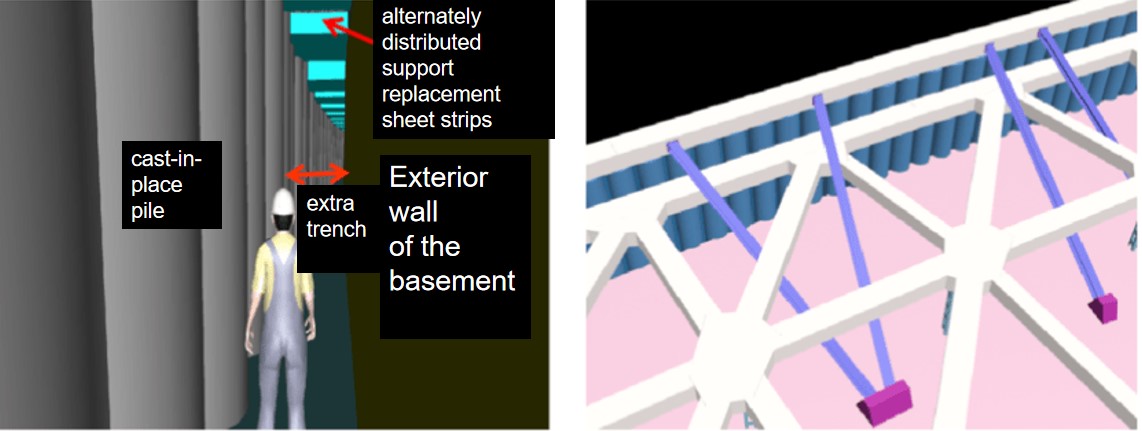
In the process of sorting out problems in drawings, more than 1,200 joint review records of civil drawings were kept. Detailed design of drawings was carried out according to the requirements of civil construction, and a total of more than 50 distribution drawings of reserved holes and more than 1500 masonry brick layout drawings were generated.
 -Joint review and detailed design of M&E drawings: Inter-discipline pipeline collision inspection and comprehensive pipeline layout were conducted for M&E engineering. Especially in complex areas, the three-dimensional model was used to find various problems such as "error, conflict, omission and deficiency" in CAD drawings efficiently to avoid reworking. More than 500 records for joint review of drawings and more than 50 comprehensive pipeline layout optimization drawings were generated.
-Joint review and detailed design of M&E drawings: Inter-discipline pipeline collision inspection and comprehensive pipeline layout were conducted for M&E engineering. Especially in complex areas, the three-dimensional model was used to find various problems such as "error, conflict, omission and deficiency" in CAD drawings efficiently to avoid reworking. More than 500 records for joint review of drawings and more than 50 comprehensive pipeline layout optimization drawings were generated.
At the same time, the space of all equipment rooms was optimized to ensure the operation space required for equipment installation, commissioning, operation, maintenance, and repair, and meet the functional and aesthetic requirements. A total of more than 30 equipment room optimization drawings were provided.
In addition, since main installation materials for the Project were purchased according to the quantity in the bidding list after review, waste of pipes often occurred. The BIM list can be used to calculate the material consumption accurately, thus saving the project cost.
c) Site layout and optimization
-Optimization of earthwork road: The project site is narrow, and the basements of all plots are connected to form a long-strip foundation pit. The boundary of the foundation pit is close to the existing pipe gallery on the middle ringside, and only the outer ringside can be used for the temporary works and roads of the Project. Therefore, the excavated roads in the earthwork stage were optimized to ensure smooth traffic.
-Optimization of tower crane position: An internal reinforced concrete support was designed for the deep foundation pit of the Project. The tower crane shall be kept away from the internal support as well as the frame beam and column of the main structure, and meet the requirements of jacking the attached wall and later removal, leading to great difficulties in layout. The optimal layout of the tower crane was achieved by integrating the foundation pit support drawings and main structure drawings, and establishing and optimizing the tower group model.
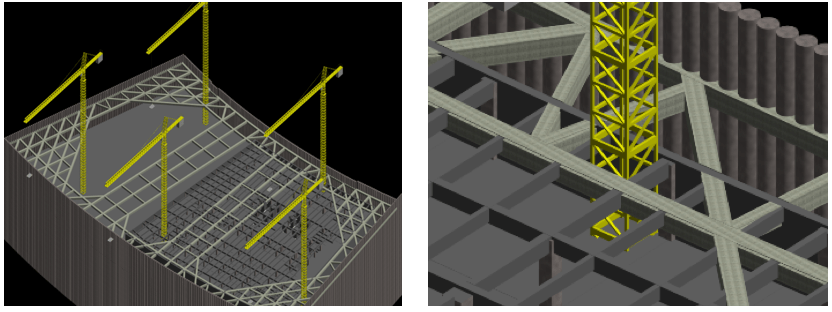
d) Comparison and simulation of a method statement
-Comparison and simulation of the method statement for the waterproof curtain: The Project is adjacent to the existing middle-ring pipe gallery, and the middle-ring pipe gallery is designed with several openings, ventilation shafts, evacuation stairs, and other protruding parts near the foundation pit side, resulting in a significant impact on the construction of the waterproof curtain of the foundation pit. The BIM team of the Project conducted simulation, comparison, and analysis for the Three-axis Method and the Trench-Cutting & Re-mixing Deep Wall Method (TRD).
According to the construction experience, the three-axis mixer needs to bypass the protruding parts of the pipe gallery for construction. Two days of adjustments and additional 2 pairs of three axes were required after each bypass; moreover, the foundation pit may leak at the corner. The TRD construction machine can run close to the protruding parts to avoid the above situation.
-Simulation of the method statement for earthwork excavation: The 3D model of the foundation pit was established for the Project. The two earthwork excavation methods, i.e., “basin-type” excavation and “island-type” excavation were simulated. When “basin-type” excavation is carried out, the area under the opposite supports is excavated to the bottom first. When the construction of the raft of basement 4 in this area is completed, the opposite supports can be removed first. The empty space can be constructed directly upwards along with the support removal area by the flow construction method. When “island-type” excavation is conducted, the angle brace area shall be excavated to the bottom first. When the construction of the raft of basement 4 in this area is completed, the angle brace can be removed only after basement 4 of the foundation pit is closed, resulting in a serious work slowdown.
The following problems are found after detailed simulation of earthwork excavation based on field conditions:
The space of the angle brace is small and the scope is large; therefore, large excavators cannot enter this area;
During the excavation of earthwork under the internal support, lattice columns and dewatering wells are distributed within the operating radius of the excavator, significantly reducing the efficiency of the excavator;
Dewatering wells are distributed within the scope of excavated roads in the pit, reducing the transportation efficiency.
The method statement of the Project is optimized immediately, the positions of dewatering wells are adjusted, the steel pipe wells are changed into sand-free strainer wells, the dewatering wells are cut off at any time during earthwork excavation, the earthwork excavation environment is optimized, and the excavation efficiency is increased from 4,000m³/day to 8,000m³/day.
-Simulation of the internal support removal scheme: The BIM technology was used to simulate and demonstrate the traditional temporary support removal process of the full scaffold; it is found that the full scaffold erection and removal are complicated, the efficiency is low, and a lot of steel pipes are required. According to research, the removal process including cutting with a new wire saw, supporting with a steel horse stool, and transporting with a forklift shall be adopted; the BIM technology was used to repeatedly deduce the spacing of the steel horse stool, removal sequence, forklift operation space, transportation path, etc. to achieve the optimal resource allocation. It is unnecessary to erect the temporary support for the full scaffold, so the quantity of materials and equipment to be leased is reduced.
b. Integrated Application of BIM
The BIM5D platform can be used to realize visual and standard safety hazards inspection and investigation, improve the pertinence of risk source investigation, assign responsibilities to individuals, trace the rectification of problems effectively, and reach the management goal of zero accident.
It can also be used to link production tasks with the model, assign the progress tasks to individuals, realize lean management of the progress, and effectively avoid unclear assignment of construction tasks and disordered production management.
The BIM5D platform automatically integrates production information and generates construction logs, solving problems such as difficulty in preparing construction logs and inaccurate recording of information.
The mobile terminal shall be used to classify and record the number of persons on-site to provide a basis for the production manager to employ staff and reasonably avoid the risk of the labor dispute.
The BIM5D platform is used to promote lean management of work quantities and control material waste on-site.
c. Research on BIM Technology
a) BIM+VR+AR technology research: Apply the most advanced VR technology, and set up 3 VR safety experience rooms to provide safety experience, education, and disclosure for field personnel. Totally 15 three-dimensional quality models are used to replace the physical models, and the mobile APP terminal is developed to ensure that the field personnel can learn anytime and anywhere; 4 software copyrights have been applied and obtained. At present, both the virtual quality model APP and the model library are improved and updated continuously.
b) Calculation, analysis, and research of deep foundation pit: Use the deep foundation pit calculation software to carry out three-dimensional stress analysis of the deep foundation pit, find out the dangerous deformation points of the foundation pit under working conditions such as earthwork excavation and internal support removal, and formulate operation instructions to guide the field earthwork excavation and internal support removal.
c) BIM + progress cloud computing: Research and develop the progress cloud computing platform under the data of the BIM5D platform, prepare the schedule based on project characteristics, and carry out inverse-calculation of the resource allocation plan to reduce the waste of manpower and materials caused by manual calculation.
d) BIM + lightweight platform application research: Realize real-time, convenient, and lightweight resource management to provide data support for project cost collection and accounting by sharing information such as sporadic labor, progress measurement, personnel input, materials, and equipment on the BIM5D platform.
The lightweight platform APP is developed and utilized to upload information such as sporadic labor, material acceptance and progress measurement on-site in real-time to ensure timely and accurate data collection and automatic generation of various ledgers.
The asset revitalization system, i.e., the idle items’ website of the China Construction Fifth Engineering Division Corp., Ltd., is used to realize resource sharing, simplify the material allocation process and improve turnover efficiency.
iv. Summary of Benefits
a. Assistance has been provided for project management and construction.
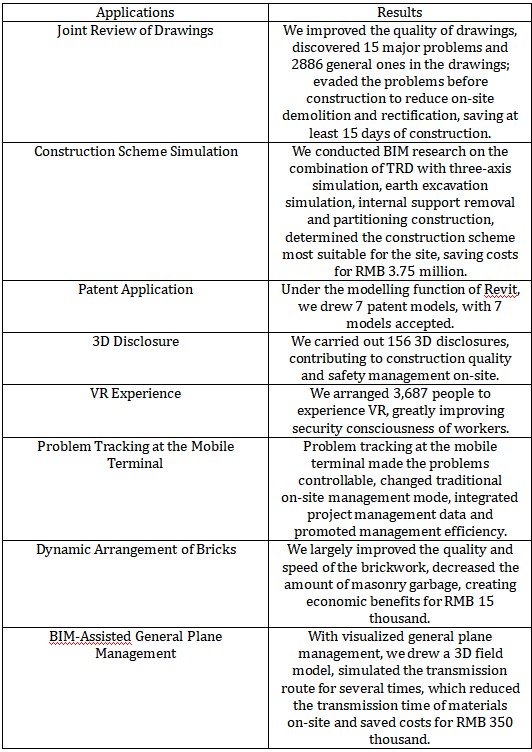
b. Economic benefits: The partial statistics show that the BIM technology has been used in the Project to find out more than 3,900 conflicts among various disciplines and optimize over 1,500 drawings. At present, it can be predicted that the economic benefits are about CNY 5.45 million, and the time benefit is about 55 days.
c. Social benefits: With the aid of BIM technology, the Project has won 1 science and technology progress award. More than 50 exchanges and training activities were performed.


